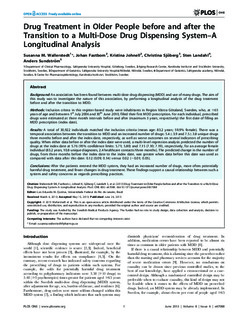| dc.contributor.author | Wallerstedt, Susanna M. | |
| dc.contributor.author | Fastbom, Johan | |
| dc.contributor.author | Johnell, Kristina | |
| dc.contributor.author | Sjöberg, Christina | |
| dc.contributor.author | Landahl, Sten | |
| dc.contributor.author | Sundström, Anders | |
| dc.date.accessioned | 2017-06-07T12:40:58Z | |
| dc.date.available | 2017-06-07T12:40:58Z | |
| dc.date.issued | 2013 | |
| dc.identifier.citation | Wallerstedt, S.M., Fastbom, J., Johnell, K., Sjöberg, C., Landahl, S. & Sundström, A. (2013) Drug Treatment in Older People before and after the Transition to a Multi-Dose Drug Dispensing System–A Longitudinal Analysis. PLoS ONE, 8(6): e67088 | |
| dc.identifier.uri | http://hdl.handle.net/11250/2445153 | |
| dc.description | Tverrsnittstudie, undersøker assosiasjonen mellom multidose og polyfarmasi hos eldre. | |
| dc.description.abstract | Background: an association has been found between multi-dose drug dispensing (MDD) and use of many drugs. The aim of this study was to investigate the nature of this association, by performing a longitudinal analysis of the drug treatment before and after the transition to MDD. Methods: inclusion critera in this register-based study were inhabitants in Region Västra Götaland, Sweden, who, at ≥65 years of age and between 1st July 2006 and 30th June 2010, filled their first MDD prescription. For each individual, prescribed drugs were estimated at three month intervals before and after (maximum 3 years, respectively) the first date of filling an MDD prescription (index date). Results: a total of 30,922 individuals matched the inclusion criteria (mean age: 83.2 years; 59.9% female). There was a temporal association between the transition to MDD and an increased number of drugs: 5.463.9 and 7.563.8 unique drugs three months before and after the index date, respectively, as well as worse outcomes on several indicators of prescribing quality. When either data before or after the index date were used, a multi-level regression analysis predicted the number of drugs at the index date at 5.76 (95% confidence limits: 5.71; 5.80) and 7.15 (7.10; 7.19), respectively, for an average female individual (83.2 years, 10.8 unique diagnoses, 2.4 healthcare contacts/three months). The predicted change in the number of drugs, from three months before the index date to the index date, was greater when data before this date was used as compared with data after this date: 0.12 (0.09; 0.14) versus 0.02 (20.01; 0.05). Conclusions: after the patients entered the MDD system, they had an increased number of drugs, more often potentially harmful drug treatment, and fewer changes in drug treatment. These findings support a causal relationship between such a system and safety concerns as regards prescribing practices. | |
| dc.language.iso | eng | |
| dc.rights | Navngivelse 4.0 Internasjonal | |
| dc.rights.uri | http://creativecommons.org/licenses/by/4.0/deed.no | |
| dc.subject | pasientsikkerhet | |
| dc.subject | legemiddel | |
| dc.subject | legemiddelbruk | |
| dc.subject | multidose | |
| dc.subject | legemiddelhåndtering | |
| dc.subject | legemiddelforskrivning | |
| dc.subject | uhensiktsmessig legemiddelbruk | |
| dc.subject | register | |
| dc.subject | reseptregister | |
| dc.subject | eldre | |
| dc.subject | regresjonsanalyse | |
| dc.subject | longitudinell studie | |
| dc.subject | Sverige | |
| dc.title | Drug Treatment in Older People before and after the Transition to a Multi-Dose Drug Dispensing System - A Longitudinal Analysis | |
| dc.type | Journal article | |
| dc.type | Peer reviewed | |
| dc.rights.holder | Wallerstedt, Susanna M. | |
| dc.source.volume | 8 | |
| dc.source.journal | PLoS ONE | |
| dc.source.issue | 6 | |
| dc.identifier.doi | 10.1371/journal.pone.0067088 | |

